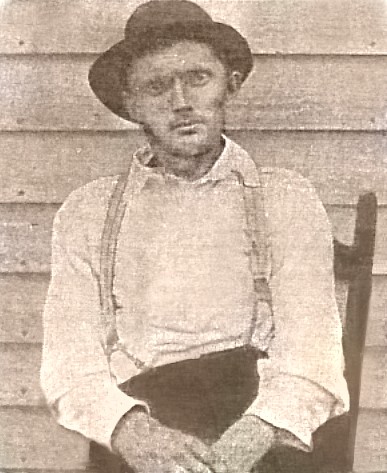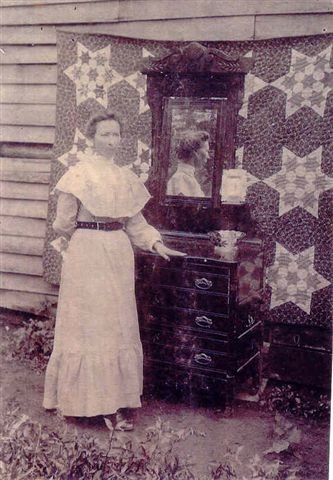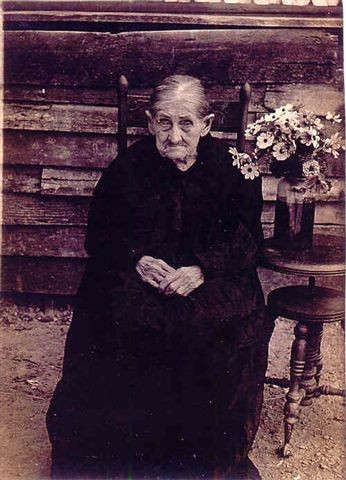Andy Holt

Andy Holt was the son of Charlie Holt and wife Elizabeth Holman Holt. He was born on September 5, 1887. After the death of Andyís mother, Elizabeth, his father married a second time, and between Elizabeth and the second wife, had a total of 21 children.
It is not known when Andy developed an interest in photography, or how he learned the technique of making pictures, but his work, I think, is quite extraordinary and of a quality that placed Andy much ahead of his time. Wilbur C. describes Andyís camera equipment as consisting of a tripod to set the camera on, and a large black cloth that extended over his head and camera to keep out light. I learned that the territory he frequented when making pictures included Wirmingham, Allons, Timothy, Willow Grove and Taylors Crossroads. If the sun set before he had time to return to his home, he would spend the night with a family who lived in whatever community he had been taking pictures in that day. Or if he was in a community when it was time for a meal, he was always invited in to someoneís home to eat. Among the many pictures I looked at that had been taken by Andy was a very interesting one he had made of a group of fox hunters. The large group of men were said to be from the Taylors Crossroads area. Several dogs were also in the picture, and a couple of men were on horseback.
An injury Andy received to one of his legs made it necessary to walk with crutches. The story goes that he was in the process of plowing a new ground, and after cutting a root from a stump with the plow, part of the root hit one of his legs with enough force to cripple him, and because of that injury, he was never able to walk normally again.
Andy was a first cousin of the Holman sisters who lived at Independence, and a good bit of his life, he made his home with the Holman family. The Holman sisters considered Andy like a brother to them. They did his washing and kept his clothes mended and patched.
Because of the many miles Andy traveled around the country side making pictures, he decided he might need to have something to protect himself with. He got permission from law officials to carry a pistol, but his reason to have this protection was not because he feared someone might try to rob him. His concern was mad dogs. He felt that because of his physical affliction, he would feel safer having a pistol nearby in the event he came upon a mad dog during some of his travels. The pistol is now in the possession of some of the family members.
Stanley Carter owns the property in the Taylors Crossroads community where the Holt residence was, and it was in one of the buildings on this property that something called glass negatives Andy had used were found. In looking at these glass negatives, I would never have known they were anything but just a piece of glass. Ronald Dishman is now in the process of carefully wrapping and packaging the glass negatives to take to Carol Roberts, Restoration Archivist, with the Tennessee State Library Archives Restoration Department in Nashville for cleaning and restoration. After the restoration process, the glass negatives should produce very clear and plain pictures that were taken over 60 years ago.
Andy Holt died on March 18, 1933 from what was told to have been TB of the leg. He was only 46 years old at the time of his death. He is buried in the Holman cemetery on the Hunter Cove Road near Allons. For many years, the Holman cemetery became overgrown and neglected, almost to be point of being totally forgotten about. The sad state the cemetery reached was quite worrisome to Miss Nova Holman and to her sister, Mrs. Estie (Holman) Newberry as well, and because of their concerns about the cemetery, two of their nephews, Robert Holman and J.D. Holman, one great-nephew, Donnie Holman, and a cousin, Danny Russell, the enormous task of clearing the growth that had completely overtaken the entire cemetery was begun. Sadly, Nova Holman died before knowing that her family members would see that the cemetery was put back in order once more. Mrs. Estie lived to the age of 102, long enough to know the work on the cemetery was finished, and her worries about this matter could finally be laid to rest. These men are to be commended for all the hard work and long hours they spent in the restoration of this cemetery. Not only was the wild overgrown state of the cemetery removed by their hard working efforts, but they saw to it that tombstones that had been broken were repaired and put back in their proper places. An attractive sign for the cemetery was placed on the Hunter Cove Road also.
A very enjoyable part of getting this story ready was looking through the hundreds of pictures Ronald Dishman has accumulated for a number of years now. He has many that were taken by Andy Holt, and I think my very favorite is the one of Minerva Tays Holman. I only wish she could speak to me from that picture and tell me all about her life. Although I have no way to know for sure, I would almost bet that the jar of flowers sitting on an old organ stool beside her had to be Andyís idea. The unidentified lady whose image was also captured in the mirror of the old dresser sheís standing in front of lets those admiring the picture see a very good example of the quite artistic side of Andy Holt. Little details like can be found in many pictures he had taken.
Because of his very talented use of what we would consider today as being very primitive camera equipment, we can still enjoy looking at pictures of those who are long gone, but will surely not be forgotten thanks to Andy and others like him. The fact that Andy was at a certain place on a certain day, doing what he obviously very much enjoyed, little bits of time from long ago have been captured and preserved, making it possible for us to hold that moment from the past in our hands and look at it with our eyes. Maybe the Overton County Historical Museum can someday have a display of the works of Andy Holt. In my opinion, it would be a very nice addition and would be a good way to honor such a talented fellow.
My sincere thanks to Stanley Carter for a very enjoyable afternoon in his home gathering information for this story, as well as a short sight seeing trip to the area near the former location of the Holt residence. Stanley is a tremendous source of historical information, and I appreciate his sharing a tiny bit of that knowledge with me for this story.

This unidentified lady's image is also captured in the mirror of the antique dresser she stands in front of. Andy's eye for details like this places him much ahead of his time in the world of photography.

The grandmother of Andy Holt, Minerva Tayse Holman, is shown in this photograph taken by Andy. Notice the fruit jar filled with flowers that sits atop an old organ stool. Andy's creative touch is seen in many of the pictures he made.

The six months old baby picture of Quannie Worley Reagan Garrett was made by Andy Holt.